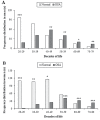Gender differences in the application of anthropometric measures for evaluation of obstructive sleep apnea
- PMID: 31105888
- PMCID: PMC6508944
- DOI: 10.5935/1984-0063.20190048
Gender differences in the application of anthropometric measures for evaluation of obstructive sleep apnea
Abstract
This study aims to investigate anthropometric measures and their effectiveness as screening method for diagnosing obstructive sleep apnea (OSA) in each gender. We also evaluated which measures were associated with OSA in the adult population of a large metropolitan city, Sao Paulo, Brazil. 552 women and 450 men were submitted to polysomnography (PSG), and the anthropometric measurements as body mass index (BMI), waist-to-height ratio, neck and waist circumference were collected. The measurements were then compared with the OSA classification established by the PSG. In women, waist circumference and waist-to-height ratio were found to be the best predictor, while in men, the factors with great potential for identification varied according to severity of the disease, highlighting waist-to-height ratio, neck circumference and BMI had strongest association. The accuracy of the classification in relation to mild-to-severe OSA based on cut-off values of 92.5cm for waist circumference was greater than 72.9% in men, and 78.9% in women based on cut off values of 95cm. Regarding severe OSA, cut-off values of 116.1cm were greater than 91.3% accurate in the male population, and 95.1% in the female population with a cut-off value of 126.5cm. The study found waist circumference and waist-to-height ratio to be the best measure to assess sleep-disordered breathing in women. Waist-to-height ratio and neck circumferences were the best measures in men with mild OSA, but BMI was more closely associated with severe OSA. The present study identified the anthropometric variables with the highest risk for OSA and their respective cutoff value, according to gender.
Keywords: Abdominal Obesity; Body Mass Index; Sleep; Waist Circumference; Waist-Height Ratio.
Figures


Similar articles
-
Polysomnography in patients with obstructive sleep apnea: an evidence-based analysis.Ont Health Technol Assess Ser. 2006;6(13):1-38. Epub 2006 Jun 1. Ont Health Technol Assess Ser. 2006. PMID: 23074483 Free PMC article.
-
Influence of gender and anthropometric measures on severity of obstructive sleep apnea.Sleep Breath. 2012 Dec;16(4):1091-5. doi: 10.1007/s11325-011-0607-9. Epub 2011 Oct 28. Sleep Breath. 2012. PMID: 22033627
-
Waist-to-height ratio and waist circumference as the main measures to evaluate obstructive sleep apnea in the woman's reproductive life stages.Women Health. 2021 Mar;61(3):277-288. doi: 10.1080/03630242.2020.1862386. Epub 2021 Jan 3. Women Health. 2021. PMID: 33390097
-
Anthropometric Indices of Obstructive Sleep Apnea Patients in Mauritius.Cureus. 2024 Oct 30;16(10):e72708. doi: 10.7759/cureus.72708. eCollection 2024 Oct. Cureus. 2024. PMID: 39483600 Free PMC article.
-
Comparison of Anthropometric Data Between Asian and Caucasian Patients With Obstructive Sleep Apnea: A Meta-Analysis.Clin Exp Otorhinolaryngol. 2016 Mar;9(1):1-7. doi: 10.21053/ceo.2016.9.1.1. Epub 2016 Mar 7. Clin Exp Otorhinolaryngol. 2016. PMID: 26976019 Free PMC article. Review.
Cited by
-
Evaluation of Obstructive Sleep Apnea in Female Patients in Primary Care: Time for Improvement?Med Princ Pract. 2021;30(6):508-514. doi: 10.1159/000518932. Epub 2021 Aug 26. Med Princ Pract. 2021. PMID: 34438402 Free PMC article. Review.
-
The Predictive Role of the Upper-Airway Adipose Tissue in the Pathogenesis of Obstructive Sleep Apnoea.Life (Basel). 2022 Oct 4;12(10):1543. doi: 10.3390/life12101543. Life (Basel). 2022. PMID: 36294978 Free PMC article.
-
Sex-Specific Intubation Biomechanics: Intubation Forces Are Greater in Male Than in Female Patients, Independent of Body Weight.Cureus. 2020 Jun 21;12(6):e8749. doi: 10.7759/cureus.8749. Cureus. 2020. PMID: 32714687 Free PMC article.
-
International Consensus Statement on Obstructive Sleep Apnea.Int Forum Allergy Rhinol. 2023 Jul;13(7):1061-1482. doi: 10.1002/alr.23079. Epub 2023 Mar 30. Int Forum Allergy Rhinol. 2023. PMID: 36068685 Free PMC article. Review.
-
Diagnosis of obstructive sleep apnea in women: Is there any difference?- Experience from a tertiary care hospital of North India.J Family Med Prim Care. 2019 Oct 31;8(10):3276-3281. doi: 10.4103/jfmpc.jfmpc_609_19. eCollection 2019 Oct. J Family Med Prim Care. 2019. PMID: 31742155 Free PMC article.
References
-
- Tufik S, Santos-Silva R, Taddei JA, Bittencourt LR. Obstructive sleep apnea syndrome in the Sao Paulo Epidemiologic Sleep Study. Sleep Med. 2010;11(5):441–446. - PubMed
-
- Sleep-related breathing disorders in adults: recommendations for syndrome definition and measurement techniques in clinical research. The Report of an American Academy of Sleep Medicine Task Force. Sleep. 1999;22(5):667–689. - PubMed
-
- Black J. Sleepiness and residual sleepiness in adults with obstructive sleep apnea. Respir Physiol Neurobiol. 2003;136(2-3):211–220. - PubMed
-
- Ljunggren M, Byberg L, Theorell-Haglöw J, Lindahl B, Michaëlsson K, Lindberg E. Increased risk of heart failure in women with symptoms of sleep-disordered breathing. Sleep Med. 2016;17:32–37. - PubMed
-
- Drager LF, Lorenzi-Filho G. CPAP for obstructive sleep apnea and the metabolic syndrome. N Engl J Med. 2012;366(10):964–964. - PubMed
LinkOut - more resources
Full Text Sources
